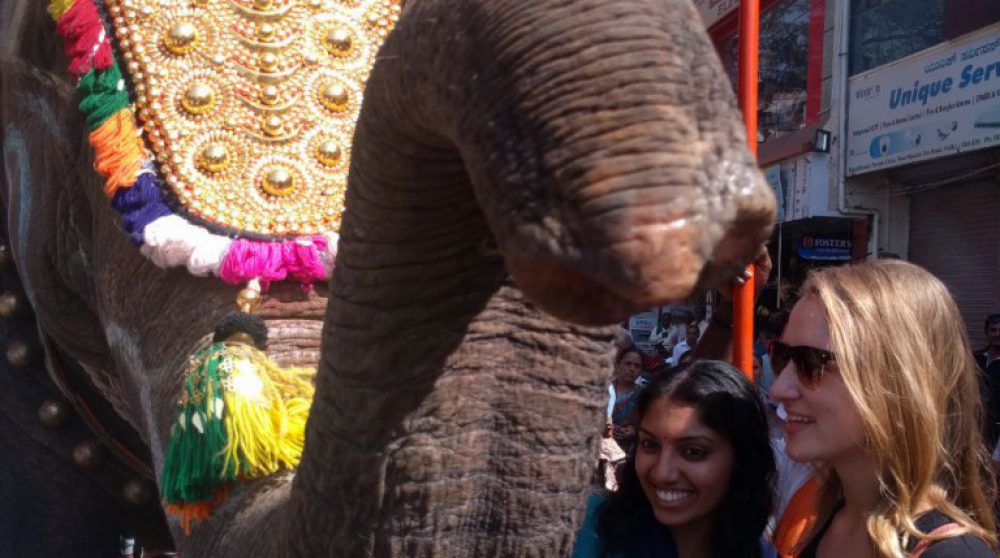When I was in Agra, people referred it as Lohri, back in Hubli it is referred to as Sankranti, and I have learned that there are a few other names in other parts of India such as Pongal and Sukarat. For me the festival started after our class finished our dinner at the lovely Clark Shiraz hotel in Agra. It was still early in the night, so me and my classmate Jen went to explore the hotel, starting at the outdoor pool. From the pool we spotted a large, well-constructed bonfire. We were kindly invited to join the people at the bonfire, who turned out to be a film production company on a company outing. Soon after we were all given popcorn and peanuts. As per tradition, we all danced around the fire and threw the food in. It was explained to me that this was an offering to the fire god to bring a good harvest for the next crop cycle. I found this to be such a very fun and festive tradition. The next day we left the hotel to begin our journey to Jaipur. Once we finally got to Jaipur I could see that festivities were far from over. The holiday was being celebrated as a kite festival. We arrived at a jewelry store and after a quick visit went to the rooftop of the tall building. When I got to the top and took a look around I was amazed. Everywhere I looked there were people out on the rooftops flying kites. Thousands of kites filled the air from every direction. I had never seen anything like this before, I had not been used to such incredible participation in festivals, I feel like this sort of event would never have been possible back home in Mass. Even I tried flying a kite up on the rooftop, but without much success. Looks like I’ll need to get some practice before the next festival. We went back to the hotel after some time. After checking into our rooms and having dinner we decided to go explore the rooftop. Once we got there we could see that this amazing festival was not over yet. By now it was dark, and all the kites were now replaced by sky lanterns and fireworks from all directions. There were even more fireworks than when we had New Years in Hubli! I returned to the rooftop later in the night and got to see sky lanterns continue to pass over me. The whole festival experience was incredible. It was really one of the things I loved about India. Everyone getting together with friends and celebrating around a campfire, on the rooftop with kites, and even at night again with fireworks and lanterns, with your entire city participating right alongside you. I’m so grateful I was able to experience this festival during the trip.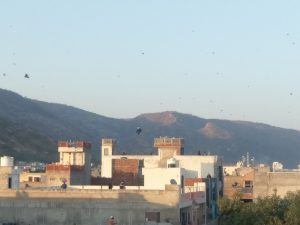
Category Archives: Uncategorized
Akshaya Patra
When I first heard that we were going to be leaving the scholar’s house at 6:30 a.m. for a field trip, I’ll admit I was less than excited. I didn’t know much about where we were going, only that it was some sort of large kitchen. We travelled by bus and when we arrived we all removed our shoes and entered a large reception area where the tour guides began to explain the mission of Akshaya Patra. According to their presentation, many of India’s underprivileged children attended public government schools. These schools did not provide food to the children and many were unable to afford food of their own. This led to thousands of underprivileged children skipping out on school because they were too hungry, and as we know, education is one of the most effective ways to break a cycle of extreme poverty. This is what inspired the founders of Akshaya Patra, making sure that no child is deprived of education due to hunger. The Akshaya Patra foundation is a non-profit organization that is essentially a series of enormous kitchens that cook hot food for all the government schools in their surrounding area. For some of the children that attend these schools, this food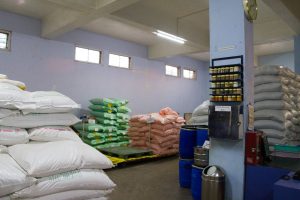 will be the only thing they eat all day. Our tour began with the dry storage room. There was an impressive store of several tons of basic food ingredients. They then showed us a large device used to clean the rice. The guides explained that the government of India actually provided the rice to them for free, but it was the lowest quality of rice, and contained bits of metal and other impurities. But by the time the rice reached the end of the magnificent cleaning machine, it looked good as new.
will be the only thing they eat all day. Our tour began with the dry storage room. There was an impressive store of several tons of basic food ingredients. They then showed us a large device used to clean the rice. The guides explained that the government of India actually provided the rice to them for free, but it was the lowest quality of rice, and contained bits of metal and other impurities. But by the time the rice reached the end of the magnificent cleaning machine, it looked good as new. 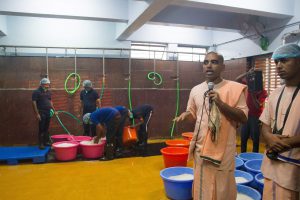 We got to see the top floor where the rice and vegetables were prepared for cooking. The entire room was filled with thick steam from the rice cooking below. One of the things that struck me most about this facility was how hygienic everything was. In this stage of the production all the rice was thoroughly washed and even the raw vegetables were rinsed in chlorinated water to ensure food safety. Not only were these people giving children a meal to eat, but one they knew would be safe and clean. Next, we got to go to the heart of the building, the kitchen. This Akshaya Patra kitchen in particular was known for being the largest kitchen in all of Asia. The room itself consisted of at least a dozen of industrial-scale pressure cookers. On one side of the huge room rice was being cooked, and on the other, was sambar. I was totally blown away just looking at the literal tons of rice being processed. As I watched the workers empty the cooked rice out of one of the cookers, it looked like each massive scoop could feed a family for a week.
We got to see the top floor where the rice and vegetables were prepared for cooking. The entire room was filled with thick steam from the rice cooking below. One of the things that struck me most about this facility was how hygienic everything was. In this stage of the production all the rice was thoroughly washed and even the raw vegetables were rinsed in chlorinated water to ensure food safety. Not only were these people giving children a meal to eat, but one they knew would be safe and clean. Next, we got to go to the heart of the building, the kitchen. This Akshaya Patra kitchen in particular was known for being the largest kitchen in all of Asia. The room itself consisted of at least a dozen of industrial-scale pressure cookers. On one side of the huge room rice was being cooked, and on the other, was sambar. I was totally blown away just looking at the literal tons of rice being processed. As I watched the workers empty the cooked rice out of one of the cookers, it looked like each massive scoop could feed a family for a week.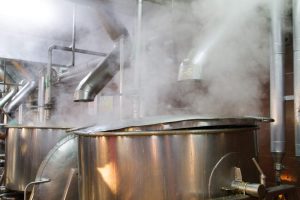
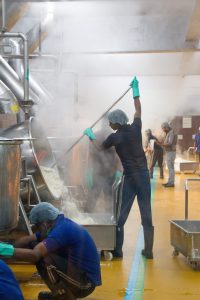 The kitchen was said to currently serve around 150,000 children in the area but had the capacity to serve up to 250,000. I thought this was very forward-thinking to have an operation like this be so scalable if the need should arise. After the kitchen we went outside to see the hundreds of trucks that took the food to schools all over the area in time for lunch. At the end of the tour they saved some rice and sambar for us to try. I have to say, I was VERY impressed! The food was delicious! Just goes to show you that food made with love tastes much better.
The kitchen was said to currently serve around 150,000 children in the area but had the capacity to serve up to 250,000. I thought this was very forward-thinking to have an operation like this be so scalable if the need should arise. After the kitchen we went outside to see the hundreds of trucks that took the food to schools all over the area in time for lunch. At the end of the tour they saved some rice and sambar for us to try. I have to say, I was VERY impressed! The food was delicious! Just goes to show you that food made with love tastes much better. 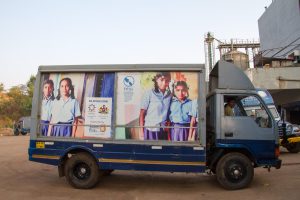
Rock Garden
One of my favorite weekend activities was our trip outside Hubli rural Karnataka. There we found the hidden gem, Rock Garden. All I had known about this place was that there was a mud bath, which had been previously discussed and I was strongly looking forward to. We arrived at first to a barren looking parking lot that was seemingly in the middle of nowhere. We then lined up in front of a cave and when we got through, I could tell there was much to see at this hidden park. First, we were greeted by dozens of statues of Karnataka’s own Rajkumar. Although I had never seen one of his movies, I could tell from the statues that he must have been a talented actor to play so many different roles. I soon found out that this Rock Garden parks claim to fame was having a world record for most cement statues. With that in mind, the detail and accuracy of the statues was quite impressive. I was reminded of the detailed wax figures I had seen at wax museums back home. After the beginning of the park which contained more famous figures of Karnataka. The park transitioned into statues and scenes that depicted traditional village life of Karnataka. This was my favorite part of the trip. Since I had spent my whole trip in urban areas, I had little perspective on rural village life, and I wanted to see as much of India as I could. Granted I understand that much of what I saw would be a somewhat outdated view of what village life is like in the 21st century. 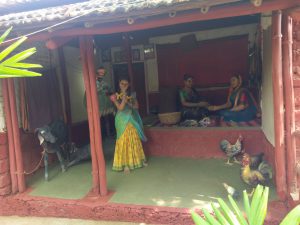
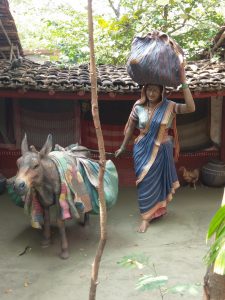
But nonetheless it was a great learning experience. After hundreds of statues and a paddleboat ride, we finally arrived at the main event, the mud bath. I decided to get things started and jump in first. The cool mud felt very refreshing after spending the whole day in the sun. As we learned in one of our in-class videos, it only takes one person to start a movement. Soon after the first couple of us went to start playing in the mud, many others soon started to join us. Each new person was welcomed with a typhoon of mud splashed from all sides. Soon almost our entire group was splashing around in the mud. Even people who originally said they wouldn’t participate in the mud bath eventually joined in. Except for all the dirt I got in my eyes, it was an incredibly fun experience. After we were done in the mud there was still more fun to be had. What better way to wash all that mud off than with a rain dance! By the time we were clean and tired from dancing, we all got changed and started heading back toward the bus. For us foreign students, even this was an exciting experience. The Rock Garden was being visited by hundreds of school children, and apparently, they find foreigners very interesting. As I walked back from the mud bath it was hard not to feel like a celebrity, dozens of children were running up to us asking what are names were and wanting to shake our hand. At points it actually got a bit hectic, but we all made it back okay. Rock Garden was the perfect Karnataka weekend trip and I would be happy to go back. 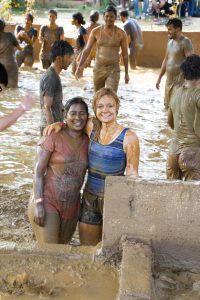
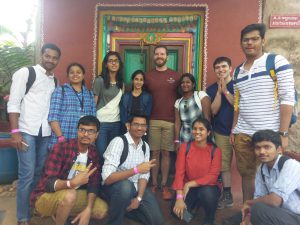
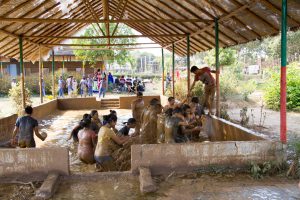
Road Troubles
tolHey there,
Once our class was finished, we had the opportunity to tour the Northern region of India. We flew from Bangalore to Dehli and then drove to Agra, Jaipur, and back to Dehli. Of course, not without a few road bumps along the way…
Meet the bus:
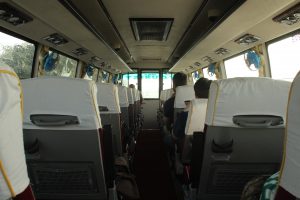
I picked the back row so I would have the best room and the most space to spread out and lay down when I wanted to. I made a great decision! I also brought my converter multi-plug extension cord which everyone was very grateful to be able to use on the long 4-5-6-7 hour bus rides.
ROAD BUMP #1: Police Speed Trap
Just five minutes from the airport pick-up spot, the bus was pulled over on the highway for “speeding” –which he was not… AT ALL. In the image sequence below, you can see the officer walking into the 3rd lane of traffic to pull a woman over for speeding (even though you cannot see her in the first frame). Apparently, the police have quotas and will often pull people over and will charge a fee before they let the drivers back on the road with the threat of writing them a formal ticket… basically, they pull random people over who appear to be rich to get their money. A tourist bus filled with white people and a single woman in a nice Porsche seemed like great targets, However, we never got a full story from the bus drivers, the above information was told to us by our Indian student translators who were speculating based on past experiences.
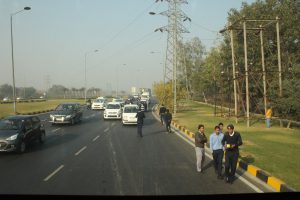
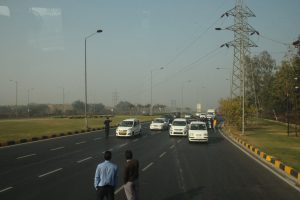
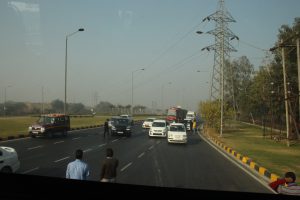
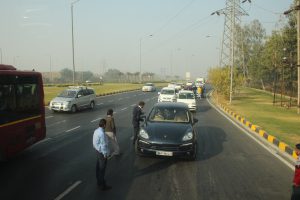
ROAD BUMP #2: Flat Tire
A few hours away from Dehli we were on the highway completely surrounded by farmland when our tire burst. I had just woken up from my nap while everyone else was asleep. I had started looking out the windows and I saw a few ostrich, so I reached for my camera and started changing the lens when the right back tire (right underneath me) burst, making a loud pop and jumping the whole bus. The bus drivers got to work immediately to put the spare on (another old and beat up tire). We all ended up getting off the bus for a stretch break and I took it as an opportunity to brush my teeth after a long night and day of travel.
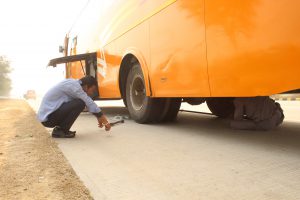
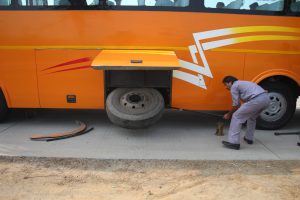
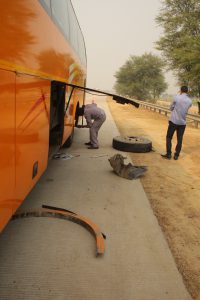
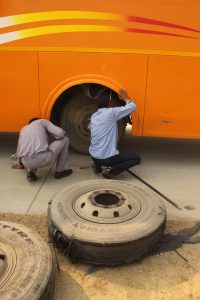
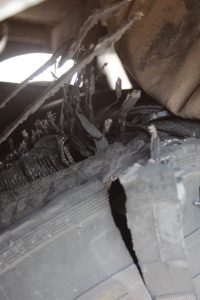
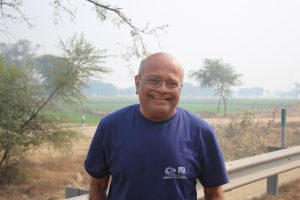
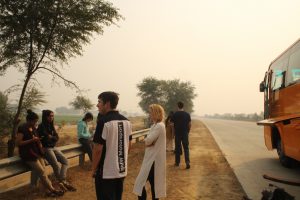
ROAD BUMP (or obstacle) #3: Flipped Lorry (truck)
As a part of my research for my class project, I learned a lot of statistics about road accidents in India. India has the most fatal accidents in the world. The worst part is that bystanders don’t stop to help because they are often afraid of having to pick up the medical bill or be a witness in a dragged out court case. As you can see, only one person is helping this victim.
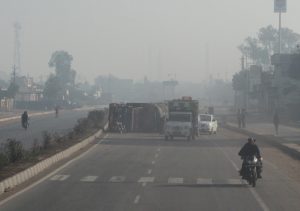 ‘
‘
Road Trip as a Whole
The rides were long and harsh, there are many tolls, tons of traffic and the days were long and exhausting. I would never imagine doing the Rickshaw Run Race across India.
-Jen S.
Dressing up for Culture Day
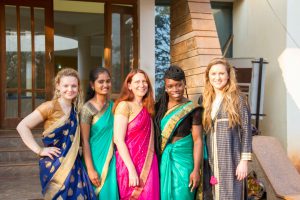

One of the best experiences on this trip was prepping for the cultural day. On Monday, January 8th, 2018 we celebrated culture day by dressing in our traditional clothes and show up to class. We were also informed that a special meal will be arranged for us on that day and would be something to look forward to. A day of cultural representation and appreciation; I couldn’t wait.
I must admit, I wasn’t prepared with any cultural clothes from back home but it was still important for me to participate. The other girls from the US and I decided to dress like an Indian woman and to experience their culture! So it was set, on Sunday afternoon we ventured out to purchase our very first saris for the next day of class. I was looking forward to it. Being the shopaholic I am I knew that this experience would be one for the books.
We arrived at the sari store and as we entered the store were asked to take off our shoes. We were invited to sit on padded mats with the sari seller. We formed a small circle and left an open space in the middle for him to display the saris. It was familiar to story time back in third grade except for this time the sari seller was the storyteller as we navigated how the story would be told based on our comments and questions. We started off my mentioning our budget to him and he started to call out to his co-worker who was in charge of getting the saris off the shelf to him. It was beautiful the process that is. One by one box of saris were open before us and thrown unto the mat one after the other. Whatever we liked we were asked to select and put to the side for further consideration. About 50 saris later I found it! The perfect color combination and pattern. I tried it on in the mirror and got feedback from Laura. “You look like a queen” she said and was finally convinced. After getting the saris we visited nearby shops to purchase our tops and the skirt that went underneath.
The next morning some aunties from campus came by to get us ready. When we arrived to class I was pleased to see how many people participated. Everyone was dressed so nicely and colorful. We took lots of group pictures and ate a beautiful culture meal for lunch that was served on a banana leaf!
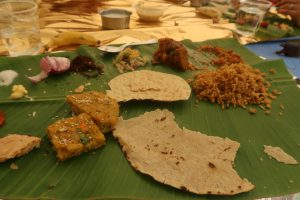
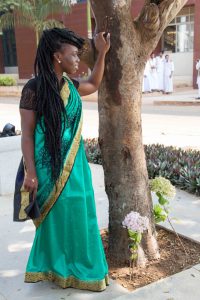
Classroom and Project Experience
Overall, I really enjoyed our classroom experience. I found the daily lectures to be very enlightening about Entrepreneurship and Innovation. I also appreciated the in class team activities, such as building a structure out of straws and tape capable of holding a small load and making something creative with paper and cardboard. I felt these activities were a great opportunity for the team to begin working together and learning about each other’s strengths.
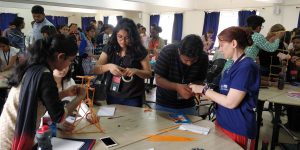
Team 1 assembling our tape and straw structure
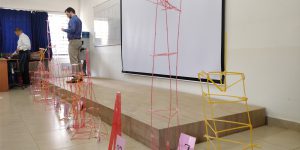
The final results
The class project was a good opportunity to learn about working with people from different disciplines and cultural backgrounds. Since my team’s product was something that was most relevant in India and less so in China or the US, the team was very dependent on the connections and local knowledge of the two local students on the team. However, as an MBA student, my business background also allowed me to be a big contributor to our team’s results. Although a lot of the required aspects of the project were addressed in class lectures, I think a team without anyone with a business background on it would have struggled a bit with the project.
Although there were many positive aspects about the class and the project, I did find some challenges as well. One of them was in communication both within my team and with other students because some students in the program had some difficulty with English and there are also some differences in words being used between the different countries. Another challenging aspect was in understanding the cultural differences in how we approach collaborative projects in the US vs. India. The Indian students seemed to identify someone as a leader and then defer to that person to make most of the major decisions instead of everyone taking responsibility for their own piece of the project. In most of my experiences in the US, project work is typically split up between the team members and they each take responsibility for their own individual portion.
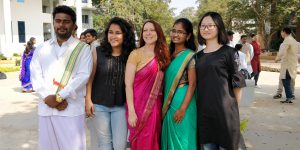
Team 1: Shubhang, Jheel, Laura, Ramya, Ling on Traditional Day
Tip for future students: Start working on the project as soon as possible, the 2 weeks goes by very quickly and there isn’t as much time during the class to work on the project as you might think. Make sure you set clear expectations among the team members and keep lines of communication as open as possible.
Fun times in India to remember forever
Currently sitting in my room, sipping a cup of tea (one I wish was Chai tea with those delicious cookies from the classroom!), and reflecting on the past three weeks. What a time it was!
I am so grateful to have met the students from all over that I did, I certainly made friends for life. Looking back, there is not one thing I would change about my experience. It has been 5 days since we left India for America, and my fellow students and I are still in contact with our new Indian, Chinese, and Japanese friends! We miss them already!
In India, we got to explore so much in and outside of the classroom at K.L.E. Tech, in Hubli. Our first day off we explored a beautiful temple in downtown Hubli with some of our fellow students to show us around. We ended that day with shopping for new Kurtas!
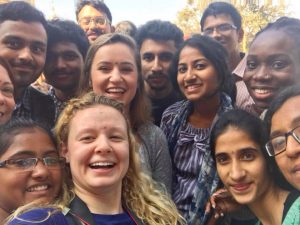
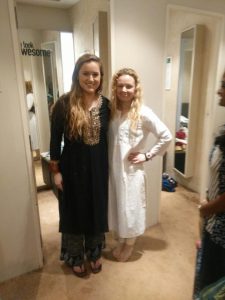
Some of our other adventures while in Hubli included visiting a Rock Garden, with a MUD BATH! A few of us went in, with hopes to get bonus points on our grades (ha-ha)!!
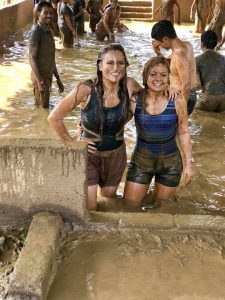
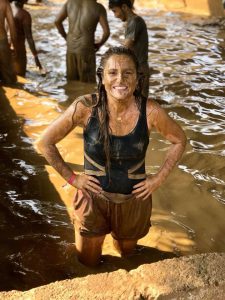
Overall, Hubli was one of the best parts of the trip, and getting to explore our new friends’ native land was extra special, too.
Looking back at these pictures, I am missing everyone!
-Emily 🙂
India: Working in the Classroom
Hello, again!
I was not able to post this in India, due to the lack of down-time…we really kept ourselves busy! After our orientation on Friday night when we arrived to K.L.E. Technological University, we got to know some of our fellow students from China, Japan, and India a bit more. It was really cool to have some time before we entered the classroom to get to know everyone a little bit.
On Saturday, we entered the classroom for the first time and officially met with our four other group members. We were all so excited to begin our work! The first couple of days consisted of us getting to know each other by completing small, yet effective classroom activities that we had to work together to solve.
As the days went on, we began our projects and got more in depth. We became more and more comfortable with each other, with lots of inside jokes! My group’s project was based on E.P. Carrillo, a cigar company based in the Dominican Republic. Our group had to decide whether or not a social media marketing method was worse or better than the traditional methods of marketing such as billboards, newspapers, and posters. Through thorough research, we decided that a mixture of both methods were a good idea!
After the two weeks in the classroom were up, it was finally time to present. Each group (14 of us groups!) prepared a 15 minute presentation to show the class what we had been working on together. It was truly incredible to see all of the hard work everyone put into each project.
Being in the classroom with everyone taught us so much more than just entrepreneurship or business. It taught us how to work with students from other countries, and bring our own cultures together to solve problems and create solutions. 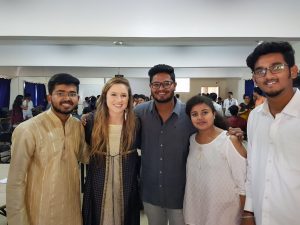
Group Project
The main output of this program is the presentation of the case study. At the beginning of the course, everyone was assigned to a group which has the specific product or service. The goal is to develop the startup business model using the product or service.
I was assigned a team consisting of 5 members and they other than I were Indian students. Three of them were undergraduate students from KLE university and the other one was MBA student from AURO university. Our assigned project was “CHATBOT” which is AI based conversation service like Siri in iPhone. And we discussed how we can tap into this technology for the healthcare industry, especially for a hospital to reduce the waiting time and to improve the quality of healthcare services.
The process of the business model development was very exciting but tough. To understand the customer, we had to implement the market research including customer interview. We went to hospitals in Hubli to interview physicians and hospital administration staffs and we finally collected 16 interview samples.
The biggest challenge was the preparation for the presentation. The given presentation time was only 15 minutes but the preparation required more than 1 week! The group that has team members who have different background and culture needs more time than usual to understand each opinion.
But finally, we made it complete the presentation and delivered in an effective way. I learned a lot from this group project and the team members became life-long friends!
Takuro Kusano
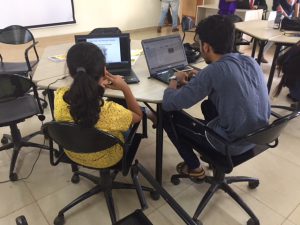
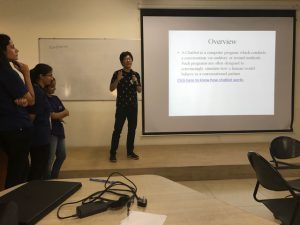
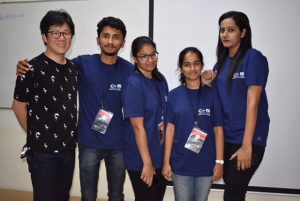
New Years Day: Temple and Shopping
I wasn’t able to make my blog posts during the trip because we were just so busy and there was so little downtime. The spotty wifi on campus didn’t help either.
Now that I am home, I wanted to share some of the experiences we had outside of the classroom. One of the most memorable experiences to me was going to a local temple (Sri Siddharoodha Swami) in Hubli on New Years Day, our first day off since we arrived on Dec. 29th. We went with a group of students in the program. The foreigners were treated like celebrities and many people wanted pictures with us or to shake hands. The temple itself was very beautiful and the local students showed us how to receive the blessings at the temple.
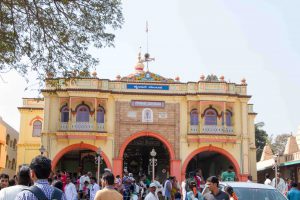
Sri Siddharoodha Swami Temple, Hubli
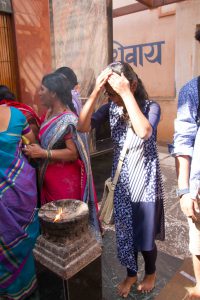
Ramya (local student from KLE) receiving the blessing
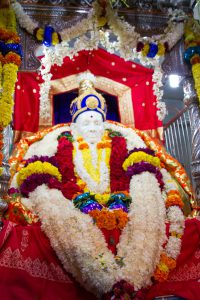
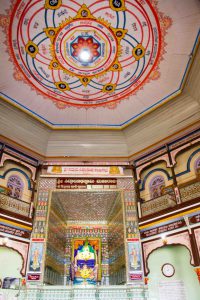
Afterward, we went to the mall to eat lunch and shop for some Indian fashions. I bought 2 kurtas (long tunics), another top, and flowy pants for the equivalent of about $35 USD. Lunch in the mall cost about $3 and I had an ice cream for about $1.20. The ride in the auto rickshaw (aka auto) was $1.50 (100 rupees) for 4 passengers. We couldn’t believe how much cheaper everything was than at home.
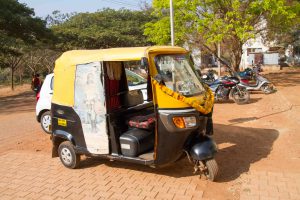
Auto Rickshaw (aka Auto)
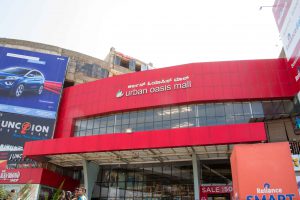
Urban Oasis Mall
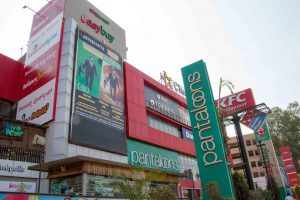
Pantaloons – where most of the shopping was done
Tip for future students: Be aware that you will be asked to take your shoes off in many places you visit in India, so don’t be like me and forget to get your pedicure done before the trip. Also, always carry hand wipes with you so you can clean your feet after walking around barefoot or your hands after using the restroom or before and after eating (most restrooms did not have soap or hand towels).
— Laura
